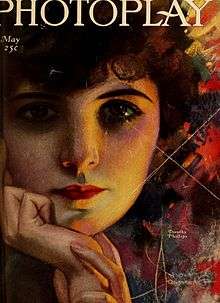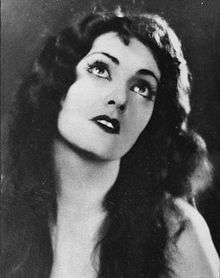Rolf Armstrong
| Rolf Armstrong | |
|---|---|
 Self portrait, 1914, pastel on board | |
| Born |
John Scott Armstrong[1] 21 April 1889[2] Bay City, Michigan,[2] United States |
| Died |
22 February 1960 (aged 70)[3] Oahu, Hawaii |
| Nationality | American |
| Education | Art Institute of Chicago[4] |
| Known for | Pin-up art, Illustrator |


Rolf Armstrong (April 21, 1889 – February 22, 1960) was an American painter of pin-up art.
Biography
Rolf Armstrong was born in Bay City, Michigan on April 21, 1889, to Richard and Harriet (Scott) Armstrong. His father owned the Boy-Line Fire Boat Company, which included a line of passenger ships. Some were deployed in Chicago for use at the Chicago World's Fair there in 1893. However, the father's business and family were struggling, and the family homestead was lost to foreclosure. In 1899, the family moved to Detroit, Michigan.
Rolf's father died in 1903, and a year later he and his mother moved to Seattle, Washington, following the footsteps of his oldest brother, William, who had moved there a year earlier. By now Rolf's artistic interests were emerging to more than a part-time pleasure.
He moved to Chicago in 1908, where he later studied at the Art Institute. He then went on to New York, where he studied with Robert Henri.
After a trip to Paris in 1919 to study at the Académie Julian, he returned to New York and established a studio. In 1921 he went to Minneapolis to study calendar production at Brown & Bigelow.
During the 1920s and 1930s, his work appeared on many pieces of sheet music, as well as on the covers of many magazines, most famously for movie fan magazines such as Photoplay and Screenland. His work mostly consists of women; Mary Pickford, Bebe Daniels, and Greta Garbo are just a few of the numerous he painted.
Armstrong's work for the Pictorial Review was largely responsible for that magazine achieving a circulation of more than two million by 1926. A year later, he was the best-selling calendar artist at Brown & Bigelow. In 1930, RCA hired him to paint pin-ups to advertise their products, and in 1933 the Thomas D. Murphy Calendar Company signed him to produce a series of paintings for their line.
Rolf Armstrong died in 1960 on the island of Oahu, Hawaii as one of the best "pin-up" artists of the first half of the twentieth century.
Gallery
 Woman's Home Companion, April 1916
Woman's Home Companion, April 1916 Metropolitan, August 1918
Metropolitan, August 1918 Mae Murray, Photoplay, August 1918
Mae Murray, Photoplay, August 1918 Anna Q. Nilsson, Photoplay, November 1918
Anna Q. Nilsson, Photoplay, November 1918 Anita Stewart, Photoplay, December 1918
Anita Stewart, Photoplay, December 1918 Metropolitan, January 1919
Metropolitan, January 1919 Norma Talmadge, Photoplay, January 1920
Norma Talmadge, Photoplay, January 1920 Olive Thomas, Photoplay, February 1920
Olive Thomas, Photoplay, February 1920 Alice Joyce, Photoplay, March 1920
Alice Joyce, Photoplay, March 1920 Pearl White, Photoplay, April 1920
Pearl White, Photoplay, April 1920 Clara Kimball Young, Photoplay, May 1920
Clara Kimball Young, Photoplay, May 1920 Martha Mansfield, Photoplay, July 1920
Martha Mansfield, Photoplay, July 1920 Rubye De Remer, Photoplay, February 1921
Rubye De Remer, Photoplay, February 1921 Priscilla Dean, Photoplay, March 1921
Priscilla Dean, Photoplay, March 1921 Dorothy Phillips, Photoplay, May 1921
Dorothy Phillips, Photoplay, May 1921 June Caprice, Photoplay, June 1921
June Caprice, Photoplay, June 1921 Bebe Daniels, Photoplay, August 1921
Bebe Daniels, Photoplay, August 1921 Betty Blythe, Photoplay, September 1921
Betty Blythe, Photoplay, September 1921 Agnes Ayres, Photoplay, October 1921
Agnes Ayres, Photoplay, October 1921 Marion Davies, Photoplay, November 1921
Marion Davies, Photoplay, November 1921 Lillian Gish, Photoplay, December 1921
Lillian Gish, Photoplay, December 1921 Olga Petrova, Photoplay, March 1922
Olga Petrova, Photoplay, March 1922 Mabel Ballin, Photoplay, June 1922
Mabel Ballin, Photoplay, June 1922 Alice Terry, Photoplay, September 1922
Alice Terry, Photoplay, September 1922 Bebe Daniels, Screenland, January 1930
Bebe Daniels, Screenland, January 1930 Rudy Vallée, Screenland, January 1930
Rudy Vallée, Screenland, January 1930
Rolf Armstrong's Gallery of Screen Beauties
In the January 1930 issue of Screenland, Rolf Armstrong chose sixteen actresses to symbolize different colors. Here are the original captions and portraits in the order which they appeared in the magazine.[5]
 White - Light could not be painted without it. No other color can take its place. - Mary Pickford
White - Light could not be painted without it. No other color can take its place. - Mary Pickford Lemon Yellow - The tip of a flame. Pale winter sunlight. - Ann Harding
Lemon Yellow - The tip of a flame. Pale winter sunlight. - Ann Harding Chrome Yellow - The gypsy color—primitive, elemental. - Lupe Vélez
Chrome Yellow - The gypsy color—primitive, elemental. - Lupe Vélez Cadmium Orange - The glowing combination of red and yellow. - Bebe Daniels
Cadmium Orange - The glowing combination of red and yellow. - Bebe Daniels
 Rose Madder - Dusky, rich, deep red—color of roses and rubies. - Estelle Taylor
Rose Madder - Dusky, rich, deep red—color of roses and rubies. - Estelle Taylor Cobalt Violet - Evocative of fragile, costly, sophisticated femininity. - Corinne Griffith
Cobalt Violet - Evocative of fragile, costly, sophisticated femininity. - Corinne Griffith Cobalt Blue - Clear, definite, polished blue of enamels. - Billie Dove
Cobalt Blue - Clear, definite, polished blue of enamels. - Billie Dove Willow Green - Youth. The color of Spring. - Nancy Carroll
Willow Green - Youth. The color of Spring. - Nancy Carroll Cerulean Blue - Smiling, unclouded perfection of summer skies. - Vilma Banky
Cerulean Blue - Smiling, unclouded perfection of summer skies. - Vilma Banky Emerald Green - Gay, vivid, daring—a rollicking, sparkling color. - Marion Davies
Emerald Green - Gay, vivid, daring—a rollicking, sparkling color. - Marion Davies Ultramarine Blue - Vigorous, direct—color of sunny seas. - Mary Brian
Ultramarine Blue - Vigorous, direct—color of sunny seas. - Mary Brian Purple - The regal color. Fire of red, spiritual range of blues: transparent, yet with the power and depth of dark tones. - Gloria Swanson
Purple - The regal color. Fire of red, spiritual range of blues: transparent, yet with the power and depth of dark tones. - Gloria Swanson Indigo Blue - Mysterious, oriental, dramatic, exotic. - Eve Southern
Indigo Blue - Mysterious, oriental, dramatic, exotic. - Eve Southern Vandyke Brown - The tone of Rembrandt shadows—deep, remote, warm. - Evelyn Brent
Vandyke Brown - The tone of Rembrandt shadows—deep, remote, warm. - Evelyn Brent Ivory Black - Impenetrable, sombre, yet capable of innumerable variations of beauty. - Greta Garbo
Ivory Black - Impenetrable, sombre, yet capable of innumerable variations of beauty. - Greta Garbo
See also
- Pin-up girl
- List of pinup artists
- Jewel Flowers
- Uncle of Hollywood Actor Robert Armstrong (actor)
Notes
- ↑ Dobson, Wooldridge 2001 (p. 10.)
- 1 2 Kusmierz, Marvin (2008). "Rolf Armstrong (1889-1960)". Bay-Journal. Retrieved 10 December 2010.
- ↑ "Paid Notice: Deaths ARMSTRONG, ROLF". The New York Times. 22 February 2000. Retrieved 10 December 2010.
- ↑ Dobson, Wooldridge 2001 (p. 13.)
- ↑ Armstrong, Rolf (January 1930). "What is Beauty?". Screenland. New York City: Screenland Magazine, Inc. Retrieved October 20, 2015.
References
- The Great American Pin-Up, by Charles G. Martignette and Louis K. Meisel, ISBN 3-8228-1701-5
- Rolf Armstrong: The Dream Girls by Ben Stevens
- Dobson, Janet; Wooldridge, Michael (2001). Pin up Dreams: The Glamour Art of Rolf Armstrong. Watson-Guptill Publications. ISBN 0-8230-4015-1.
External links
- Rolf Armstrong artwork can be viewed at American Art Archives web site
- AskArt auction records for Rolf Armstrong art
| Wikimedia Commons has media related to Rolf Armstrong. |